From the Old West, to Prohibition, to the Battlefield
On the theme of “Sweet Inspirations” it is safe to say that no one ever asked why you would saw the barrel down and cut the stock off a rifle or a shotgun, because the only people who did it already knew the reason. Most of the time it was either an outlaw or a lawman, and both for the same purpose, to conceal, either in a box or other cover, under a table, or on their person, a small but powerful weapon for use at close range.

Sawed off shotguns came first, most prominently during the Civil War for mounted troops, later for lawmen, outlaws, and often mercantile shop and salon owners, especially in boom towns. By the end of the 19th century, sawed off shotguns and rifles were not that uncommon but used far less often than more conventional lever action carbines and short-barrel double guns and pump action shotguns.
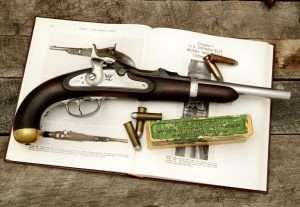
Cut down double rifles, as opposed to double barrel shotguns, were something else altogether and were eventually built that way from the start in mid to late 19th century Europe. They were known as a Howdah Pistol. The technical description of a Howdah, as outlined by arms historian Robert J. Maze in his 2002 book Howdah to High Power is that of a “large-caliber (typically rifle caliber) handgun. Multi-barreled designs were initially favored for Howdah pistols because they offered faster reloading than was possible with contemporary revolvers.” They also offered the advantage of significantly larger calibers than a revolver could provide. For hunters in Africa and India the Howdah was regarded as the last line of defense against large game at close range. Although originally intended for use in only the “gravest extremes” during the late 1880s Her Majesty’s Royal Army officers adopted the Howdah pistol as a defensive weapon carried in the many far flung outposts of the British Empire. Staring down the twin barrels of a large bore Howdah was a foreboding sight. This was the same idea Ithaca had with its c.1922 smoothbore double barrel pistol, only for use with 12 ga., .20 ga. and 410 ga. shotgun shells, rather than rifle caliber cartridges.
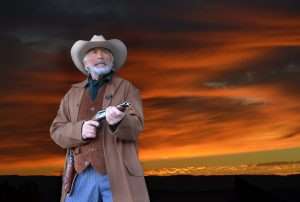
What you see here is a modern copy of a Howdah style Ithaca shotgun pistol manufactured today in Italy by Pedersoli and based on the actual Ithaca 10-inch barrel length Flues Model break-open pistol introduced in 1922. They were manufactured in the U.S. through 1925 and an improved model was built until 1934. The grip shape is nearly identical including the integrated spur to stabilize the gun in the hand during recoil, (a design seen on many Howdah pistols), a sliding thumb operated safety and break-open lever.
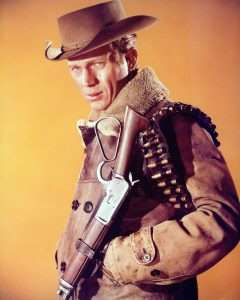
As rifled barrel pistols designed today to fire a .45 Colt cartridge or chamber 410 ga. shotgun shells, the Pedersoli Howdah’s rifled barrel design and use as a cartridge pistol circumvents the federal regulations established in 1934 by the National Firearms Act (NFA). The NFA made ownership of a sawed off shotgun or rifle illegal without federal registration and paying a $200 tax. The retail price for the Ithaca back in the early 1930s was $40 and thus an additional $200 tax and a stack of government paperwork brought an end to production of the model Ithaca called the Auto & Burglar. The Pedersoli has resurrected the design as a handgun in a federally legal version. The original double barrel pistols were smoothbore shotguns, and like the original sawed off shotguns carried over from the Wild West, found a new use in the hands of 1920’s and ’30’s Prohibition and gangland mobsters until the federal government stepped in with the NFA. Ultimately, gangsters still used them and regular folks, who may have kept one at home or in a retail store for protection, either had to break the law to keep them, turn them in, or go through the process of obtaining a permit and paying the tax stamp fee.
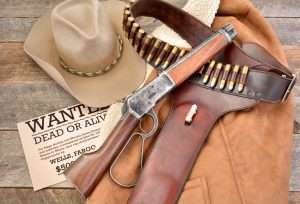
Sawed off rifles, on the other hand, were a pretty interesting commodity in the Old West, either made by a man with a hacksaw, a gunsmith, or in some cases by companies like Winchester, which called their short barreled lever action rifles the Trapper Model. They came with barrels as short as 12 inches (but with carbine length shoulder stocks). Examples like the cut down barrel and sawn off buttstock Winchester used by Steve McQueen in the television series Wanted Dead or Alive were “based” on real guns from the Old West, but made a bit more visually appealing with the large loop lever (like John Wayne used in the movies) and a custom belt holster so it could be carried on the hip and drawn as fast as a revolver.
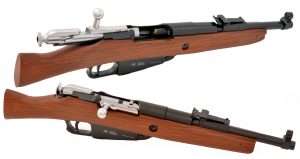
Now, imagine going back to the early 20th century and finding out that during the Russian Revolution, older Mosin-Nagant bolt action rifles were cut down in much the same fashion and used by Russian dissidents during the October 1917 revolution. Known as an Obrez the guns were mostly modified early Model 1891 Mosin-Nagant rifles with the stocks cut off behind the wrist and barrels shortened to as little as 12 inches, pretty similar to a lever action western rifle only with a cartridge magazine and a bolt action.
One Out of Three
Of this interesting trio of historic arms, only the Mosin-Nagant pistol has been reproduced as a CO2 model. Frankly, it is almost surprising that this unusual early box magazine, bolt action rifle designed by Russian military officer, Captain Sergei Ivaonvich Mosin and Belgian armsmakers Emile and Leon Nagant, would have been the gun of choice for being cut down. A bolt action pistol is not exactly a fast handling gun. Even more unlikely is that the Mosin-Nagant Obrez would become the basis for an air rifle pistol conversion. The Obrez designs varied from maker to maker with most crudely built and not well finished like the Gletcher Mosin-Nagant Model 1891 CO2 version.
In Russia, the rifles used to make the sawed off pistols were never actually called a Mosin-Nagant. The actual name was 3-Lineyaya Vintovka obr 1891g (3-line rifle, model of 1891). Original rifle production began in 1892 at the Russian ordnance factories at Tula, Izhevk and Sestroryetsk. The Model 1891 and subsequently improved models and variations were used by Russian (and later Soviet) soldiers through WWII, so it became a very famous infantry rifle. They were built in several versions for the Russian Army as a rifle (and sniper rifle), as a carbine and for mounted cavalry as a Dragoon with an even shorter barrel, probably the basis for the Obrez favored by irregular forces and partisans for its easy concealment under clothing. It was also popular with Russian organized crime for the same reason.
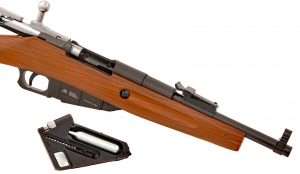
This Gletcher model, which comes and goes from the Gletcher line, like the full-size M1944 rifle, is probably one of the most under valued and under rated CO2 models on the market today, and certainly one of the, if not the most unusual pistols ever made.
If necessity is the mother of invention, than war and crime is the mother of necessity. Most of the firearms developed in the 19th and early 20th centuries were built for offensive or defensive use in war; certainly many were also designed and built as target and hunting rifles, and even target pistols. There is, however, a fine line that separates that distinction, and everything needs to be viewed in the context of the times; we simply cannot subject 19th century thinking to 21st century interpretation.
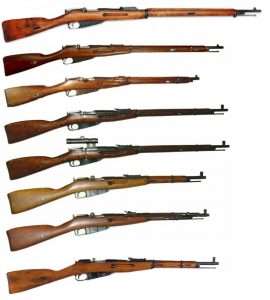
Shortening the barrel and cutting the stock off at the wrist, as was done with older Mosin-Nagant bolt action rifles around 1917, perhaps even earlier, was done during desperate times in war by men whose very lives were at risk for having such a weapon. With the Model 1891 this was done most famously during the Russian Revolution, which began on March 8, 1917 and ended with the abdication of Czar Nicholas II, bringing an end to Czarist ruled Russia. Mind you, this all occurred in the midst of World War I, a war in which Russia was taking heavy loses in the fight against Germany. Within a matter of months Russia’s post-Czarist government was foundering, which led to the October Bolshevik Revolution and the beginning of the Soviet Union. However, the rise of Lenin as head of a new government was not entirely successful, and multiple factions arose leading to a Russian Civil War in the middle of a World War. The Great War ended in 1919 but the Russian Civil War lasted until 1923 with Lenin and the Red Army victorious. A year later Lenin died and Joseph Stalin rose to power as leader of the Union of the Soviet Socialist Republic. All very interesting politically and historically, but also very much intertwined with the archaic weapons still being used in Russia during WWI and throughout the Civil War, the Mosin-Nagant in particular, which was developed during the reign of the Russian Czars and then used to overthrow them.
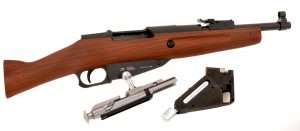
Even though the Mosin-Nagant was designed before the turn of the century, it was so well built that, with later improvements in 1930, it remained in use by Soviet troops throughout WWII (rather famously), and well into the late 20th century. Primarily the design of Sergei Mosin, Leon Nagant’s designs were also employed in the bolt action and other parts of the gun when it was manufactured and eventually both men were paid equal sums for the rifle’s development, though neither of their names would be officially tied to it. The Mosin-Nagant label is simply preferred over the military designation “3-Lineyaya Vintovka obr 1891g.” What exactly is 3-Lineyaya? It translates to 3-line, a reference to the caliber, 3-line being 7.62mm.
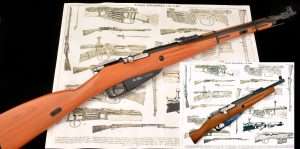
The rifles employed the Sergei Mosin and Leon Nagant designs for the bolt handle and safety, which was engaged by pulling the cocking piece to the rear and rotating it left, allowing it to hook over the rear of the receiver, a very simple but reliable means of putting the gun on safe with a chambered round. The horizontal position of the turn bolt handle might seem awkward in appearance today, compared to more “elegant” bolt action designs with curved bolt handles that rest against the side of the stock, but Mosin’s design proved remarkably quick to operate in the field.
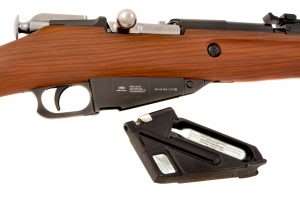
CO2 Version
As noted in Part 1, the Gletcher M1891 uses a removable box magazine that holds the CO2 cartridge and a load of 16 BBs. The original M1891 had an integral magazine with 5-rounds fed through the open action using a stripper clip, which was very common at the time. Unlike the Obrez models, which often had the sights removed and were not aimed so much as “pointed”, the Gletcher version uses the ruggedly-designed M1891/30-style sliding tangent rear and hooded front post sights, the /30 indicating the improved version of the M1891.
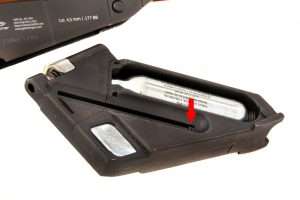
The wood-grained stock is synthetic but has a nice appearance and smooth reddish-brown finish. It also has the correct style finger grooves set along the sides of the forend. With an overall weight of 5.6 pounds it is a hefty little gun but an accurate copy of the Obrez variations, right down to the operation of the action, trigger, and the removable bolt. Gletcher has done an excellent job copying this somewhat obscure variation of the gun.
BBs & Velocities
Since the Gletcher M1891 was introduced four years ago there have been two developments in .177 caliber BBs, copper-coated lead Smart Shot, which is heavier than steel BBs and thus delivers lower velocities but allows shooting at reactive metal targets, and frangible composite .177 caliber Dust Devils, which are lighter than steel or lead BBs and can be used with metal targets. Neither Smart Shot nor Dust Devils always reliably work in all magazine-fed CO2 pistols and rifles. So, first up is a velocity and function test of Dust Devils in the 16-shot, bolt-action pistol.
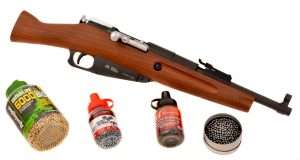
One of the problems Dust Devils have is feeding and with the easy loading of the Gletcher M1891 magazine (through the firing port) light follower spring and the unique angle of the BB feeding column of 45 degrees, function with Dust Devils should be excellent. There were zero failures to feed from the magazine and average velocity was 380 fps.
Next up, I shot Umarex Precision steel BBs which averaged 366 fps. To give some balance to the velocity test I switched my steel BBs to Remington brand plated steel, which delivered an average of 368 fps, and then Hornady Black Diamond black anodized steel BBs which clocked 378 fps average. The factory specs say “average velocity 427 fps” but not with anything I have been able to find.
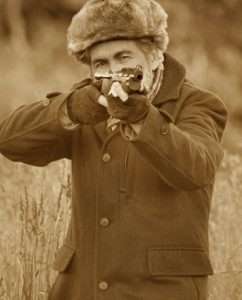
As a pistol (this is hardly what you could call a carbine without some form of shoulder stock) the Obrez Gletcher model is not a typical BB gun, but with its short barrel, very solid heft, slick bolt action and good sights, at ranges from 21 feet to 10 meters or so, it can keep .177 caliber BBs close enough to make shooting this unique airgun an interesting experience.

